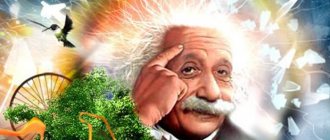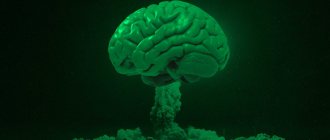Imagination is a unique ability of human consciousness to create images, ideas, new ideas and objects from objects that in the real world are not perceived by him as a single whole (they do not exist or are incompatible).
Imagination is a form of mental reflection of the world, the basis of visual-figurative thinking, which allows a person to solve the tasks assigned to him without resorting to practical actions. Consciousness allows you not only to transform familiar things, but also to use them for your own purposes. It allows a person to plan, model, create, play and remember.
Important! Imagination develops in childhood and improves in adulthood, but only with constant training.
Without knowing how to develop fantasy and imagination, you need to pay attention to the exercises described below and reading good books.
Development Tools
The main ways of high-quality development of imagination are the acquisition of multifaceted and full-fledged life experience through daily communication with people, taking part in all kinds of events, and performing various tasks. The more development techniques are accumulated, the more an adult achieves sensory, mental, and emotional experience at the same time. As a result, we begin to eliminate logical inconsistencies in our consciousness that are provoked by lateral thinking. Although there are no universal recommendations in psychology regarding the development of imagination in an adult, it is worth paying close attention to the process of reading, which contributes to the expansion of models of the surrounding reality.
People perceive the model of the world differently, which makes it difficult to assume an objective interpretation of reality. In the proverb that is familiar to many that there are no comrades according to taste or color, precisely this formulation of different perceptions of reality is well reflected.
But any imaginary model can be mentally expanded, trying to understand why others perceive a certain event differently. Methods for developing your own imagination involve trying to look at the world through the eyes of your interlocutor. Experiment with different exercises to develop your creative imagination. Today feel like a teenager, tomorrow - a pensioner, the day after tomorrow - a woman nursing a baby. Such mental transformations will have a positive effect on thinking and will become a way to develop fantasy along with imagination.
Books that develop imagination
Many rationally thinking people refuse to read books written in the genre of science fiction and fantasy, and do not read fairy tales and stories where the author deliberately lies. They believe that such reading is intended for children and adolescents and is unworthy of an adult. In reality this is not the case.
Fairy tales and interesting fantasy stories help develop imagination not only in children, but also in adults. If reading something like this is not interesting, you can study one of the following educational books:
- "Six Thinking Hats" (Edward de Bono);
- "A Beautiful Mind" (Michael Michalko);
- “Methods for the development of memory, imaginative imagination, thinking” (Igor Matyugin).
Interesting, but far from scientific works that allow you to significantly expand the limits of the reasonable, are books for the development of imagination by the following authors:
- Stephen King;
- Joanne Rowling;
- Michael Crichton;
- Patrick Suskind;
- Michael Bulgakov.
It is worth emphasizing once again that reading science fiction helps develop imagination to unprecedented proportions. This is why small children so easily make up funny stories about their toys, parents, and friends, while adults find it difficult to do this. In childhood, everyone fantasized, but as they grew up, they forgot about this ability.
A person may well exist without imagination, but the ability to recreate new images and ideas is never superfluous.
Why develop?
Using various methods of developing one’s own imagination, a person acquires a unique ability to expand consciousness, create mental images, form new ideas, imagining objects that are not perceived in reality as comparable. Thanks to this quality, we develop imaginative thinking, and it already allows us to solve various problems without even using practical actions.
Using games and tasks recommended by psychology to develop imagination and tasks, a person learns to transform familiar objects, using them for his own needs in an unusual way. This allows you to plan new goals, model behavior, create through visual activities, play, and better remember information.
Games aimed at developing imagination begin in childhood, and then they are only improved by adults with constant training. If you don’t know good ways to develop your imagination, pay attention to reading books.
Functions
- Prompting activity with the help of a bright, attractive image of its result, means and methods of implementation, generalized ideas and specific plans.
- Regulation of behavior in an uncertain, problematic situation with the help of images of alternative actions and their consequences.
- Emotional self-regulation, autopsychotherapy, illusory satisfaction of needs. This function comes with the risk of escaping reality. Replacing reality with gaming images is one of the consequences of gambling addiction.
- Organization of cognition - reconstruction of an object according to description, completion of missing elements, modeling.
Ways to develop fantasy
Many adults are almost completely deprived of this quality. It is difficult for them to come up with tasks to develop their imagination, since they are not even able to compose a fairy tale for a child, come up with an interesting joke, draw a humorous picture, or create a carnival costume.
The fault is not a lack of talent - in fact, the problem is that a person does not know the techniques for developing his own imagination. It is necessary to perform special exercises to develop creative imagination, which help overcome the lack of imagination.
Developing a rhythm of attention
To perform the exercise recommended by methods of developing the imagination, you should completely relax, concentrate all your attention, directing it to your hands. Completely empty your skull, discarding any extraneous thoughts. Repeat this workout every day for 10 minutes, periodically changing your viewing angle or body position.
The main goal is complete concentration on the hands at the same time as the absence of any extraneous thoughts. It is allowed to blink, but it is not advisable to look away; just watch your hands.
Imprint
To develop imagination and good spatial imagination, find an object in the room that immediately attracts the eye. Then concentrate your attention on it for at least 5 seconds, taking a mental photograph of this thing.
Close your eyes, hold your breath for a few seconds, and try to reproduce what you saw in your memory. As you exhale, free your consciousness from the picture, as if erasing it from your memory. This is a good option for developing your creative imagination.
Photo manipulation
A good way to develop spatial imagination is to mentally imagine a specific object, which then needs to be moved in space, changing its dimensions and shape. Connect several objects together or split the whole picture into its individual fragments.
Move each mentally photographed object, change its shape, having previously determined the desired direction. You should train in this way until everything becomes easy.
Ability to see
Another option for recommendations regarding exercises for developing spatial imagination is training with matches. You need to prepare a couple of hundred matches. Find an assistant who will dictate certain words. You need to associate them with the appropriate way by laying it out from the matches. The exercise can be completed when you have managed to reproduce at least 50 words. After the dictation, you need to reproduce the words you heard out loud, looking at the combinations of matches. Using such options for developing imagination through different means, you will be able to achieve significant success.
Ability to find solutions to problems
Before moving on to tools for developing productive imagination, it is important to note that everyone has the ability to imagine creatively. The human mind has an important property, which is the presence of an incentive to eliminate logical contradictions.
For example, many smokers, knowing about the serious harm of smoking, always know how to explain to themselves and the people around them the reason why they do not give up this harmful habit. It turns out that smokers are faced with an internal contradiction “smoking is good - smoking is bad”, which in psychology is called cognitive dissonance (see Wikipedia). This contradiction causes psychological discomfort, and people are forced to come up with all possible ways to eliminate this contradiction, and some of them reflect the high creative abilities of a person: smoking can be harmful, but pleasant, smoking helps creativity, puts you in the right mood, helps train breathing, reduces weight etc. Almost every smoker has his own excuse, which was caused by a logical contradiction.
It turns out that a person is initially programmed to struggle with contradictions and look for a way out of the current difficult situation. In the previous lesson, we had many modified judgments regarding the object in the chosen focus. At the stage of breaking the pattern, we violated logic and came to dissonance, which will have to be corrected with the help of our imagination, life experience and natural predisposition to a certain type of thinking. Moreover, the ability of people to effectively search for solutions to logical contradictions is stronger, the more experience a person has, ideas about various models of behavior and other knowledge about the world around him.
To understand how this mechanism works for you personally, and also to train your imagination, we suggest you complete an exercise called “Jumbled Letters in Words”
Exercise “Jumbled letters in words”
This exercise does a great job of showing that our brains can find and understand the meaning of words, even if they are deliberately trying to confuse it. This happens because we do not read letters and syllables, but words as a whole, and in addition, we understand the meaning of words thanks to neighboring words and phrases that our brain has encountered before.
Statistics Full screen
Creating images
To develop imagination through visual activities, various techniques are used:
- Combination. To obtain a new unique combination, you need to perform an exercise to develop your imagination, such as rearranging individual elements. Writers, artists and scientists often use this formula in their work to make innovative discoveries. To combine elements, they do not resort to the usual mechanical combination of each individual facet of this thing. Obtaining a new image is formed on the basis of complex analytical and synthetic work. With the help of this, objects are transformed beyond recognition.
- Agglutination. The essence of this method, aimed at developing the creative part of the imagination, lies in the visual gluing of individual visual representations, which will subsequently create one whole and a new image. Examples: the design of a trolleybus simultaneously contains elements of both a tram and a bus; some fairy-tale characters are endowed with simultaneous animal and human body parts.
- Emphasis. An exercise in developing imagination when creating a new image involves highlighting specific things and omitting non-essential ones. Attention is paid to the color scheme of the selected area, but its natural size is not taken into account, which leads to the creation of a new object.
- Typing. In the process of this action, repeating objects are projected onto a separate new image for the development of creative imagination. This results in a synthesis of individual images. Writers often resort to such manipulation when they describe certain mental associations in a novel.
- Sharpening. A separate case of emphasis on visual activity. Your attention should be concentrated on the dimensions of the character and his weight. For example, it is worth using the fairy-tale Thumbelina and giant giants from science fiction works.
- Schematization. The technique involves exercises for developing your creative imagination, during which differences in consideration are erased. Other ideas are smoothed out, only general features can be exposed. These techniques are often used by scientists in technical descriptions of industrial facilities.
Using these techniques, adults are able to solve the problem.
Classifications
By degree of activity:
- Active (stimulates the implementation of created images, activates creative activity, sometimes requires great effort if the creation of images is necessary for work, for example, like writers, screenwriters, decorators).
- Passive (does not encourage a person to take active action, but only generates images in his mind with which he is satisfied without realizing them, or they are, in principle, not realizable).
By type:
- Productive (creates new elements, so-called fantasy products, something that did not previously exist).
- Reproductive (imagination based on existing phenomena and objects).
- Dreams (the process of imagination aimed at the real future).
- Hallucinations (images created by altered consciousness).
- Dreams.
In connection with past experience:
- Recreating (imagination that is based on experience).
- Creative (creating new images with minimal reliance on experience)
Development of creative perception
Creative perception itself is a type of some creative activity of the mind, during which completely new images are formed. They are based on stereotypes already in the mind. It is absolutely impossible to develop creative imagination without reading literature and making associations.
If there is a shortage of time, it is recommended to play special games that improve the development of imagination:
- Letters. You must choose any letter from the alphabet at your discretion, naming all the things that begin with it and located around it. By training in this way, a person develops memory and attention, as well as thinking and imagination. It is quite possible to imagine any missing items mentally.
- We name and describe. You will need to select any item and try to describe it more accurately. This technique not only promotes the development of creative abilities, but also enriches creative thinking.
By training daily for at least 20 minutes, you can get the desired effect:
- improve your own creativity;
- develop memory simultaneously with thinking;
- enrich yourself intellectually.
Ideal end result method
The goal of the ideal end result method is to determine the methods that are necessary to solve a certain problem, as well as to assess how effective a particular technique will be. At the same time, resource costs should be minimal, and complications and undesirable consequences should not arise.
When using this method, you need to determine which characteristics of the object are most important for solving the problem, then you need to determine the ideal solution and strive for it.
In order to formulate the ideal final result, it is advisable to follow the following recommendations:
- do not determine in advance the degree of reality of what is being done
- do not think in advance about ways to achieve results
- maximum use of available resources
- using a template solution
Brainstorming method
The purpose of the brainstorming method is to quickly find a solution to a certain problem. Participants in the discussion offer as many possible solutions as possible. Then, among all the ideas expressed, the most optimal ones are selected.
The brainstorming process consists of the following steps:
- formulation of the problem
- generalization of ideas
- selection and evaluation of ideas
The basic rules for brainstorming are as follows:
- ban on both negative and positive assessments
- unusual, fantastic ideas are welcome
- combination and improvement of ideas is encouraged.











